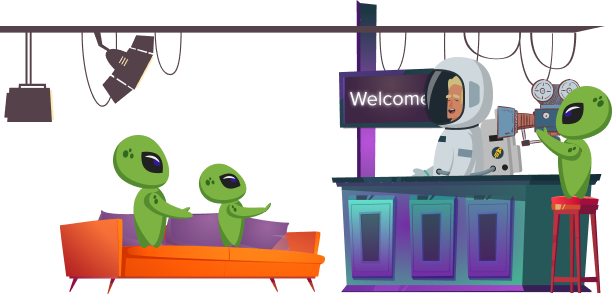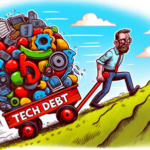Listen as Brian Pollack, CEO of Protovate, discusses how technology, innovation, rapid prototyping, and robots can help prevent future shortages, such as the current baby formula shortage.
Transcript:
SPEAKERS
Brian Pollack, Edwin K. Morris
Edwin K. Morris 00:00
This is prototyping. I’m your host, Edwin K. Morris. The cool thing is we’re talking about innovation and rapid prototyping today as it relates to the current baby formula supply issue.
How can technology better prepared to meet future demand when it comes to this kind of activity? We are exploring this from a technology and innovation angle.
Today, we’re going to peel back some of the mystery of how technology will address this in the future. I’m joined today from to do that over today on a call to talk about this rapid prototyping technology and innovation is Brian Pollack of Protovate. Brian, how you doing?
Brian Pollack
I am doing great, Edwin.
Edwin K. Morris
Awesome. I am thrilled to have you here. This is a hot topic and a hot button knee jerk reaction of multiple things that are happening out there in this field. So I want to pull in some recent facts. This is from factcheck.org. These are some of the quotes from that organization about this current issue:
“Baby formula has become increasingly unavailable in the US over the last 10 months, reaching an out of stock rate of 43% for the week ending May 8.”
Wow, that’s some critical gap there in production.
“According to experts, the US shortage has been driven largely by a recall from Abbott nutrition, a major manufacturer of formula, plus the ongoing supply chain issues exacerbated by the COVID-19 experience.”
So what kind of things, Brian, does work in technology and innovation and rapid prototyping do to help with this sort of problem.
Brian Pollack
So there’s a bunch of things that we can do with technology today and in the future. Let’s start talking though, about manpower. Essentially, a lot of this problem comes from manpower. And this is affecting a lot of industries, not just baby food formula. There aren’t enough people who are able to get into the factories, be safe, work in safe conditions and produce the products we need. And these kind of things take time.
So a shortage of people many months ago can lead to one piece, like a piece of lid to the container not being available, and any one of those pieces can lead to a supply chain shortage. Takes a little bit of time to see but you know, our locked down many months ago in this country and other countries has led basically to shortage people.
Technology is going to step in here. Over the last few years, really the last 10 years, but extremely so in the last few years. robots that can do these kinds of jobs have gotten better, their agility is more prevalent, and the cost has come down by tenfold.
It used to cost the company something like $8-10 million to put in a factory, single purpose arm to do one thing, that kind of equipment can now cost about 150, maybe $300,000. And it can do more than one thing. They are infinitely more programmable, infinitely more monitorable more flexible, and and easier to deploy. That’s making it much more likely to have products available when we need them for the supply chain. And as we look towards the future, the industry is moving one step further with what’s called robots as a service. This is a really cool concept. The idea here is if your factories running behind, or you don’t really want to invest in the infrastructure to build something out, or maybe you have a product line that runs for only 10 days, you can actually rent a fully programmed robot and a team will bring in a truckload of equipment, automate 10 or 12 steps on your product line and then run your process for a month and then they’ll pack everything up and leave. And that’s become more and more possible.
As the cost of this equipment comes down, the size comes down, the weight comes down from, you know, from one robot army staff to take on a truck. Now you can put a bunch of pieces back on a U haul. So that’s two ways that I think robots and robotics in general is going to really help solve supply chain problems in the future.
Edwin K. Morris
That sounds pretty futuristic. I’m excited to see more about that. That’s sounds like a very innovative and probably disruptive evolution here.
Brian Pollack
Yeah, absolutely. Seeing these things in action is pretty amazing, what they can do how fast they work. And especially from a technology standpoint, how quick they can be programmed to do these really flexible jobs. It used to just take an army of technicians, months, months and months to get set up. And, you know, now you can be up and running in two, three days sometimes.
Edwin K. Morris
Well, let’s talk about regulation. I hear the FDA is looking at these robots and safety is that an issue?
Brian Pollack
Safety in general is an issue, not so much for the robots, but what the FDA is looking at when it comes to baby formula is making sure that we have a safe product on the shelves, right. And no matter the pressure they’re under politically, it’s their job, their goal. And I think they’re doing the job of making sure that consumers are getting access to a product that is safe. Now robots certainly will help with that. Because the less people that have to touch something, the less steps that are manually done, the safer it’s going to be. But in general, there’s other things that are taking place in the technology world that I think is improving safety even more.
Okay, the one I want to talk about today are clinical trials. And it’s how baby formula is tested. How do we make sure it is safe? Now, whether you know it or not, you’ve been through and heard about clinical trials. That’s the idea that a company has a product, whether it’s a simple vitamin, or a really complex drug that cures cancer, or baby formula, and they have to have some scientific way of validating what it does, right, and the FDA is going to look at that data very carefully. So, these things used to be really complicated, archaic, and very expensive every time you wanted to do that, because it involves a lot of paperwork and sites and things.
Edwin K. Morris
Well, and it’s a heavy process, because it has to be scientifically monitored. So I mean, it’s just a slow process, any way you look at it, right?
Brian Pollack
It is historically a very slow process, and historically involves a lot of people on the ground, nurses and all kinds of things, a lot of coordination. But technology is stepping in, and this is something that I’ve been working on heavily for more than five years now. And that’s the idea of a decentralized clinical trial. And that means that we are bringing in people all over the country, all over the world, regardless of their location through digital technology. So we’re, we’re essentially taking what used to be a very archaic paper process that involves just a tremendous amount of paper and tracking. You can imagine how slow that is right to track data.
Someone used to take a piece of paper and copy it into Excel, then someone else used to look at that Excel and go back and look at the piece of paper and see if the first person copied it right. So we do away with a lot of that and put the software right in the hands of the consumer that allows them to track their own information. So you get information right from the source. And there’s some other advantages, too, that I won’t talk about today, what we call real world data, because instead of getting this information in a clinical setting, you’re getting information right at home.
Let me tell you how that applies to babies for a minute.
Edwin K. Morris 08:18
Yeah, please.
Brian Pollack
So imagine you’re testing baby formula and if you’re in a clinical setting, you have to try to remember the conditions, right? What can go wrong? Did your baby get sick? They have, you know, an unsettled stomach, something like that,
Edwin K. Morris
As the researchers like this call it a lot of variables.
Brian Pollack
Very true. So you can go into these clinical sites, and maybe once a week, maybe once a month, and you fill out a paper. Yeah, I think last Tuesday, my baby might have not done so well. But with real world evidence, what you’re doing is, okay, I’ve fed the formula, it’s been an hour, I’m just going to note that my baby’s doing great or even, you know, my baby seems to have an upset stomach. Let me track that in real time right now at the source. And we can put all that information in and gather much better statistics. And that’s happening right now.
Edwin K. Morris
Is this sounding to me like a crowdsource scientific method to a degree because you’re involving people in real time, right?
Brian Pollack
I don’t know if crowdsource is the right word, but kind of. So, I think crowdsource has one great connotation to it in that it involves everyone. And what these decentralized clinical studies do is bring health care to everyone.
We have a lot, especially in the US, we have a lot of underserved markets, rural areas, and the term health equity comes to mind when you talk about clinical trials that are decentralized, right, you’re giving a chance to participate, to access the latest information, to access products that wouldn’t be available all over.
Edwin K. Morris
So are these only medical people that would have access? How are you seeing more people have access?
Brian Pollack
Well, let’s say we’re studying the effects of baby food formula. Let’s look at a traditional way, right, you need to recruit people, and you need to have them come into a center. So you might have what we would call a site. And you’re going to probably do this in a big metropolitan area, because there’s more people available. And it’ll probably be around one of any, there’s really not that many places that are equipped to do this, a couple of thousand, maybe, maybe more, but still, it’s a limited number. So your, the number of people that logically could get access to that kind of study is relatively small. It’s just the people who are willing to drive to that center.
Now, if we turn that whole concept, you know, on its head and say, listen, instead of going into the site, what we’re going to do is digitally give you the legal information, digitally, tell you your rights, and get all your information from you. And we’re going to use our great postal system, we’re going to mail you the correct products to test and get your feedback. You can be anywhere. So we’ve, you know, we’re solving the problem of health equity and giving all of these underserved markets access because they don’t have to drive to this clinical location.
Edwin K. Morris 11:04
Sure. Yeah, it expedites everything.
Brian Pollack 11:06
Yeah, absolutely.
Edwin K. Morris
So how does that affect rapid? What’s your term here? How does that affect rapid prototyping?
Brian Pollack
Protovate does a lot of work with rapid prototyping. And when we originally started looking at this problem about five years ago, we wanted to quickly understand what would change the industry, what kind of technology was needed to cause a change, right. And we can guess on some things, but the best way to approach it is to develop something quickly, iterate through it.
Last time you and I talked, we talked about innovation, that’s what we apply here, we are going to build something quickly, get it in the hands of consumers get into the hands of the experts, to those who dedicate their lives to these clinical trials, they put in a tremendous amount of effort to make them successful. And we needed a way for them to be able to see and touch technology, even before it’s really fully ready for mainstream use.
So in our prototyping scenario, we spent a couple of months literally, that’s all, quickly prototyping something. We may even spend a month or two doing touch and feel visuals on a process, like this is how it might look on a phone. Even that level of prototyping, gives companies, gives consumers the ability to react, and we can see the shortcomings and see what they think of the process. So rapid prototyping, which is really available now these days, because the tools have become so much better for us as a prototyping company allowsus to quickly solve this problem.
Within a couple of months, we had a really good idea on what it would take to just change the way this industry works.
Edwin K. Morris
So this rapid prototyping lead to a solution that is now being put in the field.
Brian Pollack
Yeah, absolutely. I can’t go into details, of course. But decentralized trials isn’t something that we’re doing alone. It’s not something where we don’t actually do that. We’re the technology company behind it. But our clients that are running these decentralized studies with the software and solutions that we built for them, you know, are conceptually changing the market. There’s a lot more decentralized studies out there now than there were five years ago as a result of everybody, you know, using rapid prototyping innovation to push the strategy.
In 10 years from now I expect the majority of trials will probably be decentralized or some hybrid variation. But using direct data from the consumer, because there’s huge value in real world data and the ability to get information, right from the consumer, right when it’s important, right when it’s happening.
Edwin K. Morris
So it sounds like this will all reduce the bureaucracy that’s related to getting anything approved through the FDA.
Brian Pollack
Absolutely. So the FDA doesn’t move very quick in most cases, but I am really impressed with how quickly not just the FDA, but the FDA equivalent in other countries are moving to adopt this kind of technology. And there’s some real advantages we see. As we collect data, it’s perfectly formatted and ready to go. It can be input into their systems analyzed much quicker. I mentioned before this old process where someone would literally put something down on paper, transcribe it to Excel maybe or some other system, and then there’d be so many mistakes that you have to hire someone else to go back and check that paper. And I mean, it’s a very complicated process. Yeah, digital has really taken tremendous amount of the legwork out of that.
Edwin K. Morris
Does the, does, I don’t know if you want to go into this. I know doing clinical research and all that sort of thing. You’re talking about trying to keep identities and content secure and anonymous, is that an issue?
Brian Pollack
We can certainly talk about it. And then after that we can bring it back to so you know, how does all this stuff relate specifically to baby formula? And is there a future step? Like what’s next?
Edwin K. Morris
Okay, so, knowing clinical studies, as little as I do, I do know that privacy and protection of content and participant information is a critical thing. Is that any more or less an issue in a cyber world?
Brian Pollack
Security is always a great question. And privacy, especially with medical records is more important than ever. The industry is doing a really good job self-governing in this case, there’s nobody who wants to, you know, be in the news for some kind of data hack or something. And the industry takes it very, very seriously from at every level. And to me, it’s much more secure than the paper version. You wouldn’t believe how many copies of things exist on paper in so many places, even if they’re not supposed to. Right. And you can’t really function anonymously, when you have to go to a site and say, you know, Hi, I’m blue ten, I’m here to you know, it just doesn’t, it just doesn’t work.
In reality, things are what we see deanonymized much more often than they should be. But in the digital world, we are able to segment what we call PII, Personally Identifiable Information, in a very secure, kind of tightly stored away place, and then track everything with a unique identifier, a unique number that’s assigned to somebody specifically for this trial never reused, and it becomes a very secure way of managing data that’s been heavily vetted by security experts.
The FDA is, you know, weighs in on this kind of process. And I think the industry has really gone above and beyond to make sure that that information is well protected.
Edwin K. Morris
While we’ve talked about a lot of how things are revolutionizing as you see it in this industry, how does that all affect the current issue of baby formula?
Brian Pollack
Well, one thing that we’re gaining out of these digital trials is rapid ability to see and change with the results. Let me give you an example: We have ML or machine learning. Machine learning is just, in a nutshell, the ability to kind of process data and guess what would happen if in certain conditions.
What we can see by looking at a combination of this machine learning or AI and data as we collect it really early, instead of taking the years to compile the results. We can see very quickly, okay, this dosage versus this dosage of something is not having an effect. Let’s shift, let’s adapt this. Some call it an adaptive study. And it’s the idea that we don’t need to wait a year after, you know, we’ve put everyone through the pain of six months of doing whatever study to see the results. We can shift and change quickly. And I think AI and ML take it one step further, not today, but in the future. Because we’re formulating, not based on guesswork or based on assumptions with our products. But the machines are analyzing the data and finding things you didn’t expect, like these six people who happen to have, I don’t know, they happened to be taller than the rest, did not do as well on this formula, but did better on this almond milk version of the formula. And you wouldn’t have thought as a researcher to ask that question. But AI can come in and kind of find that correlation that you may not have even thought to ask.
Edwin K. Morris
Well, that’s a that’s a brilliant example because I think there’s probably many cases where data points like that get lost in the shuffle. And unless you’re specifically looking for something, it’s hard to see that.
Brian Pollack
Yeah, absolutely. It’s going to be a very exciting future for medicine, for sure.
Edwin K. Morris
Well, what is the future?
Brian Pollack
The future is customized medicine. And I’m working in this field a little bit, I can’t really talk about it, but I am itching to. It’s such an exciting place to be. There are systems, imagine where you could get a test that looks at you, personally, you individually, checks your blood levels, maybe even your genetics, right, things you don’t even know about your ancestry. And based on the research customizes a pill for you, or a set of pills with exactly the right dose of amino acids and other compounds that are going to work best with your genetics, your personal blood levels and your personal results. And this is a combination of really, future thinking lab systems, future thinking processing, just in time ability to produce medications, AI machine learning, in order to process you know, millions of people’s genetic data to find the similarities, it’s all kind of coming together at once.
You combine that with software, combine that with this decentralized ability to give medical treatment to underserved parts of the world and it really comes to head with some really awesome results.
Edwin K. Morris
So that future that you’ve just described where you could actually have better analysis, better prescriptive prevention, mapping the future of a person’s health, by all of these references, makes it a very holistic approach. And you’re saying that this would absolutely make equitable health care, pretty available?
Brian Pollack 20:28
Absolutely
Edwin K. Morris
Is there going to be an app? Will I be able to do a scan on my phone and say you do an iris scan or something and say, Oh, well, you’re low on zinc? And that’s why your blood pressure is so high.
Brian Pollack
You say that a little bit sarcastically, I think. The truth is, you already are probably wearing a device that can measure much more than you realize and your simple Apple Watch is not so simple. It’s collecting extremely useful information, not just while you’re awake, but extremely useful information about how you sleep and your sleep habits. And all of these things form that holistic view, as you say, of your personal health. And these companies are looking at the entire body, the entire picture of your health. How can they get tests to you quicker you think? You know, this requires bloodwork. Well you can get a test in the mail. a kit that takes just a little prick of your finger, you mail it back, and in three days, digitally, all of this information has gone through analysis by machine learning algorithms, it’s combined with all your personal data that you’ve authorized access to and then you have Edwin’s personal journey
Edwin K. Morris
Well you’re taking in, this may be a little off, but so you’re taking the concept of just in time delivery. So think of the Walmarts of the world the Costcos the whatever’s they can instantly monitor where they’re at and levels in demand, and already start to fluctuate towards the receiver side, wherever they’re getting those products from, ‘hey, we need more of this. We need less than that’. There’s more of a automatic response to consumption. So if you have that ability, then in the medical trial world or in the development of things to help people in the health system, you could really tie a bigger forecast map of supplies and demand in an instantaneous method, because now you’ve got doctor’s offices, you’ve got hospitals that are all connected. And so you’ll be able to monitor demand and supply of just about everything to do with health care.
Brian Pollack
You said so much there. So I’m gonna bring it back to baby formula. Okay? So imagine you’re one of those companies, right, and you have access to kind of a lot of data. So let’s use our with great power comes great responsibility, let’s use this for some good and say that you’re one of these big companies and they noticed that you are given a prescription for a certain medication used to treat infant diarrhea, right. And they also noticed through your point of sale history, that you’re buying certain formula. They also notice, based on your medical records from your doctor, that you’re slightly underweight, they combine a number of data points automatically through machine learning through AI and say, ‘you know what, your baby would probably do better with this other formula that’s more gentle, because we know statistically, the conditions, the medication you’re on, these are likely to be the cause of a food allergy’, or something like that, right. And that’s, it sounds futuristic, and it kind of is; we’re not there yet. But companies are setting the groundwork to do that. It requires a tremendous amount of data, it requires consumers to agree, it requires safety to be in place to protect privacy, protect your personal information, requires a lot of things to be in place and to cooperate. But you can imagine how beneficial it is when these companies can protect you from accidentally, you know, doing the wrong thing.
Edwin K. Morris
Sure, yeah. It’s almost like you’ve got a digital pharmacist and a sage as part of your physical frame now that is going to keep you safe and better protected and healthier. It also sounds like everything you just described is basically what marketing has been doing for 30 years with data, and what do they show you next, you know, and that sort of thing. But you’re basically saying take all that data, and have it set for a better use in that healthcare is a better use than, in my view, advertising. But yeah, right. I mean, it’s a lot of that activity, but more focus for a better citizen, a better health state.
Brian Pollack
I think comparing it to marketing is really a fair thing. So you know, when I think of marketing like that, I still remember that if I go out and buy something like I’m going to buy an umbrella, the next 10 things I’m going to see are for umbrellas, I already have one I just bought, okay. It’s not. It doesn’t, the way it works. It’s not smart. It’s not. Yeah, I don’t know. There’s a lot to go there but with, with what we’re doing, you know, in healthcare space, it’s really what we call a data driven approach to health care management. And, you know, I hate to say it, but you’re not always getting the best doctors in every rural community. Some people can’t, you know, drive to even a regular doctor. This doing this digitally, is just smart.
Edwin K. Morris
Yeah. Yep. I’m with you. That sounds like a great future. And I want to be part of that.
Brian, we want to have you back on and we’re going to talk more about this as things progress.
Brian Pollack 25:48
Absolutely. Thank you for the conversation today.
Protovate pioneers new software, new systems, and new ways of working to bring your concept to life. Our hybrid-shore software development outsourcing model gives you access to the ideal talent to make it happen.










